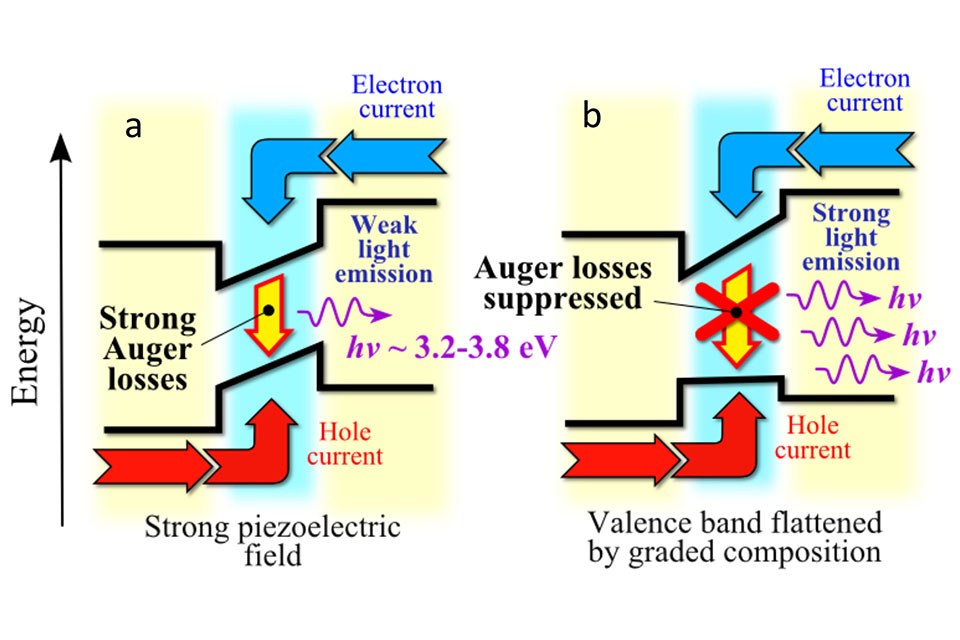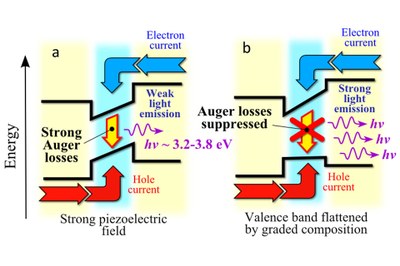A Roadmap to Efficient Green-Blue-Ultraviolet LEDs
Scientists at the U.S. Naval Research Laboratory (NRL) have suggested a method that could significantly increase the efficiency of green-blue-ultraviolet light-emitting diodes based on GaInN/GaN, AlGaN/GaN, and AlInN/GaN quantum wells. Their approach could enable advances in solid state lighting and the creation of low threshold lasers and high power light emitting diodes (LEDs). Their research is published in the January 25 and November 26, 2013 issues of Applied Physics Letters.
Epitaxial perfection in the growth of quantum wells has been the key to achieving light emitting and laser diodes of superior power, efficiency, and performance. Ternary group-III nitrides LEDs based on GaInN/GaN, AlGaN/GaN, and AlInN/GaN quantum wells now find widespread application in energy-efficient as well as decorative solid-state lighting. But their use in high-power lighting applications is currently hindered by a significant loss in efficiency even at modest electrical currents. Indeed, the quantum efficiency of the LEDs peaks at relatively low currents—a few tens of amperes per square centimeter—and then steadily drops, by almost half, as the current increases. This "droop" in the efficiency is observed in the visible, blue, as well as ultraviolet spectral regions.
Scientists at NRL's Center for Computational Materials Science, in collaboration with researchers at the Technion, Israel, and Ioffe Physical-Technical Institute, Russia, have created computational models showing that the observed droop effect arises from non-radiative Auger recombination of the injected carriers. The rate of the Auger recombination is proportional to the cube of the carrier concentration. As a result, the noradiative Auger decay rate grows rapidly with current density, quenching the generation of light.
To suppress these non-radiative Auger processes one needs to create quantum wells with a soft confinement potential. Dr. Alexander Efros, a senior researcher in NRL's Materials Science and Technology Division, previously showed theoretically that a softened electrostatic potential prevents carriers from acquiring the momentum necessary for nonradiative Auger processes, and thus suppresses the Auger decay rate. This concept was patented by NRL in March 2013. The latest calculations by the NRL-Technion-Ioffe research team demonstrate that softening the confinement potential—by varying the alloy composition along the growth direction—also completely suppresses the piezoelectric field that normally enhances nonradiative Auger processes in GaN/AlN QWs. The calculations show that the droop effect in such quantum wells can be significantly or even completely suppressed.
In addition to Dr. Efros at NRL, the members of the research team include Roman Vaxenburg and Efrat Lifshitz from the Israel Institute of Technology, Haifa, Israel, and Anna Rodina from the Ioffe Physical-Technical Institute, St. Petersburg, Russia.
About the U.S. Naval Research Laboratory:
The U.S. Naval Research Laboratory is the Navy's full-spectrum corporate laboratory, conducting a broadly based multidisciplinary program of scientific research and advanced technological development. The Laboratory, with a total complement of nearly 2,800 personnel, is located in southwest Washington, D.C., with other major sites at the Stennis Space Center, Miss., and Monterey, Calif. NRL has served the Navy and the nation for over 90 years and continues to meet the complex technological challenges of today's world. For more information, visit the NRL homepage or join the conversation on Twitter, Facebook, and YouTube. - See more at: http://www.nrl.navy.mil/media/news-releases/2014/a-roadmap-to-efficient-green-blue-ultraviolet-light-emitting-diodes#sthash.0gYJkAIw.dpuf


